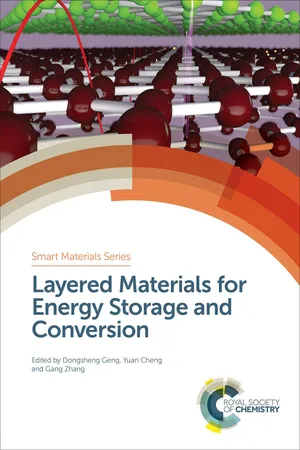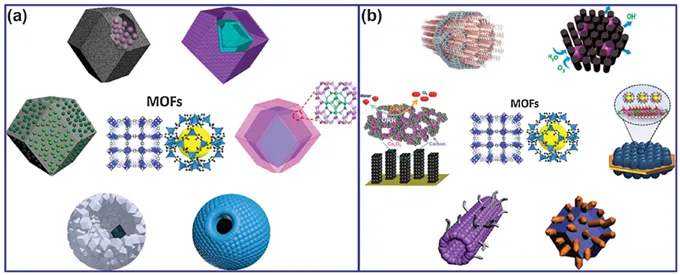![]()
CHAPTER 1
MOF-derived Materials for Extremely Efficient Electrocatalysis
ZHONGXIN SONG, LEI ZHANG, MATTHEW ZHENG AND XUELIANG SUN*
University of Western Ontario, Department of Mechanical and Materials Engineering, London, N6A 5B9, Canada
*Email:
[email protected]1.1 Introduction
Nanostructured materials such as porous carbon, metal/metal oxides nanoparticles (NPs), and their composites have been widely investigated in the field of electrocatalysis.1–5 Metal–organic frameworks (MOFs) as precursors and/or templates for the design of functional porous materials have become a rapidly expanding research area in recent years.6 As their name suggests, MOFs are constructed by periodic coordination of metal ions and organic ligands to form one to three-dimensional (3D) networks. The organic linkers are enormously diverse and have a variety of configurations. The vast numbers of metal ions and organic linkers as well as their diverse assemblies thus have led to the reporting of more than 20 000 MOFs.7 In addition to their adjustable compositions, another distinctive advantage of MOFs is their ordered pore structure, uniform pore size, and high specific surface area in contrast to traditional microporous and mesoporous materials. The pore size of MOFs can be adjusted from a few angstroms to nanometres,8,9 which enables the access of reactants and removal of products within a specific size, ensuring rapid mass diffusion and transport.
The remarkable advantages of MOF-based materials in catalysis mainly arise from the inherent properties of MOF precursors: MOFs possess highly dense and uniformly dispersed active sites; the high surface area, porous structure, and open channels facilitate rapid mass transport and diffusion. These advantages enable MOF-based nanomaterials to be promising solid catalysts, especially in electrochemical catalysis. However, the coordinatively unsaturated metal sites and nonconductive organic ligands limit MOFs to certain electrocatalytic reactions. Fortunately, this challenge can be alleviated by two approaches: (i) functional modification: it is possible to convert the metal ions into metal/metal compounds while carbonizing the organic linker into a conductive carbon support by a precise post-treatment modification. (ii) Pore encapsulation: MOF structures can incorporate various catalytic active species into their pore space and behave as nanoreactors to host catalytic reactions.10–12 Moreover, the obtained nanocomposites derived from MOF precursors display high surface area, porous structure, and uniformly dispersed active sites, which were found to be important properties in electrocatalysis. In this chapter, we describe several unique structures and compositions of MOF-derived materials, and then highlight the recent progress of MOF-derived nanocomposites for electrocatalysis. Finally, the major challenges of MOF-based materials and their research opportunities for further development in electrocatalysis are discussed.
1.2 MOF-derived Materials: Structures and Compositions
Recently, MOFs have gained increasing attention due to their ordered framework and porous structures.13–15 Enabled by their diverse structures, high surface area, and permanent porosity, MOFs are considered as novel precursors to construct functional materials such as nanoporous carbon, nano-metal compounds (e.g. metal oxides/sulphides/carbides), and their composites.11,16 Generally, MOF crystals with controllable size, shape, and compositions can be obtained by incorporating the desired metal ions and organic ligands during the MOFs’ synthesis. Subsequently, post-synthetic modification can be used to treat MOF precursors and transfer the precursors into MOF-derived materials with diverse nanostructures and compositions. This section describes the multiple nanostructures (e.g. porous, core–shell, hollow structures, and 3D composites structure, as shown in Figure 1.1) and compositions designed from novel MOF precursors, with an emphasis on their attractive properties and unique functions for boosting electrocatalysis.
Figure 1.1 Schematic of MOF-derived nanostructures: (a) MOF-derived structures, (b) MOF-derived micro/nano-composites.
1.2.1 Structures of MOF-derived Materials
1.2.1.1 MOF-derived Porous Carbon
MOFs can be used as ideal sacrificial templates to construct diverse nanostructured materials such as porous carbon, metal compounds, and their composites. These MOF-derived materials can inherit the advantages of MOF precursors, especially their high surface area and tailorable porosity. As an example, Yamauchi et al.10,17 used Zn-based MOFs (zeolitic imidazolate framework, ZIF-8) as self-sacrificing templates for the preparation of nitrogen-doped porous carbons (NPCs). The resulting NPCs not only maintained the polyhedral morphology of the ZIF-8 precursor, but also exhibited a large surface area (up to 1110 m2 g−1) and hierarchical porosity. The NPCs maintained an average pore size with a diameter of 1.06 nm, which was much closer to the pore size of the parent ZIF-8. By delicate design of the MOF precursor, for example, integrating the properties of ZIF-8 and ZIF-67 nanocrystals, the core–shell structured ZIF-8@ZIF-67 polyhedrons with ZIF-8 as the core and ZIF-67 as the shell can be well defined.18 By choosing ZIF-8 seeds with different sizes, the core size of ZIF-8 can be tuned. Simultaneously, varying the feeding molar ratio of Co2+ : Zn2+, the shell thicknesses of ZIF-67 can be adjusted. After thermal treatment of a ZIF-8@ZIF-67 precursor and then Co removal by acid etching, the functionalized nanoporous carbon hybrid with a core structure of nitrogen-doped porous carbon and shell of highly graphitic carbon (GC) was obtained. In particular, the resultant NPC@GC core–shell materials possessed an interconnected hierarchically micro/mesoporous structure due to the carbonization of organic linkers and removal of metal atoms from the parent ZIF-8@ZIF-67. These results suggest the possibility of designing MOF-derived nanocarbon with a porous character partially inherited from the parent MOFs.
1.2.1.2 MOF-derived Hollow Structures
Hollow structures with a high specific surface area (external and internal surface), enhanced material utilization and efficiency, as well as high stability, have been considered as one of the most attractive structures for energy storage and conversion application.19–21 Construction of hollow structures with tuneable architectures can be enabled by using MOF strategies. Recently, Guan et al.22 reported the ZIF-7 strategy for the fabrication of hollow structured cobalt/nitrogen-doped carbon (Co/NC) materials. In their work, ZIF-67 crystals were synthesized and self-assembled on the surface of polystyrene spheres (PS) to construct yolk–shell PS/ZIF-67 composite spheres. Subsequently, by a controlled pyrolysis, the PS/ZIF-67 composite was transformed into hollow particles with a single hole on the surface of the shell. During high temperature PS/ZIF-67 pyrolysis, the ZIF-67 micro-shells were transformed to Co/NC, while isolated Co nanocrystals were covered by a porous carbon layer. The PS sphere, a thermally degradable template, was decomposed and generated a strong gas outflux of hydrocarbon, leading to the formation of a single large-through hole on the shell of the resultant Co/NC spheres. Importantly, the authors found that the open size of the hole has a relationship with the heating rate of the pyrolysis. A higher heating rate decomposes PS more rapidly and results in a large-sized hole on the final hollow Co/NC shells.
By appropriate design of the composition of MOF precursors and by carefully controlling their subsequent post-treatment, hollow materials with unique architectures can be achieved. For instance, yolk–shell hollow structures and multi-shelled hollow polyhedrons have been fabricated by innovative MOFs’ synthesis and post-synthetic modification. In 2012, Kuo and co-workers23 coated pre-synthesized palladium (Pd) nanocrystals with a Cu2O layer, then in situ synthesized an outer shell of polycrystalline ZIF-8. The clean Cu2O layer with a capping-agent-free surface contributed to the growth of a ZIF-8 shell, which was simultaneously dissolved by the protons’ environment during the ZIF-8 synthesis. The trace amount of Cu2O residue can be removed by treatment with a solution of 3% NH4OH in methanol, thus forming the obvious void between the metal Pd cores and the ZIF-8 shells. The morphology and property of the metal nanocrystals were well preserved during the coating of the ZIF-8 shell. Through this strategy, a series of metal nanocrystals@ZIF-8 yolk–shell composites can be constructed. The yolk–shell structures suitably incorporate the functions of metal cores, porous shells, and the cavity between the core and shell, which provides a typical example in the rational design MOF-derived materials with hollow architectures. Recently, Lou et al.24 presented a two-step method to synthesize box-in-box double-shelled nanocages with different shell compositions. In their experiment, the uniform Co-based ZIF-67 NPs were synthesized in the first step. The ZIF-67 NPs were then dispersed in an ethanol solution of Ni(NO3)2 to generate ZIF-67/Ni-Co layered double hydroxides (LDH) yolk–shelled structures. After thermal calcination in air, the ZIF-67 cores and Ni-Co LDH shells can be further transformed into Co3O4 and NiCo2O4 nanocages, respectively. Both the Co3O4 inner shell and the NiCo2O4 outer shell can remain intact after thermal treatment, resulting in Co3O4-NiCo2O4 double-shelled nanocages. This two-step strategy can be applied to ZIF-67 NPs with different particle sizes, thus giving rise to the size-controlled synthesis of Co3O4-NiCo2O4 double-shelled nanocages. Several kinds of double-shelled nanocages with inner Co3O4 and out...

